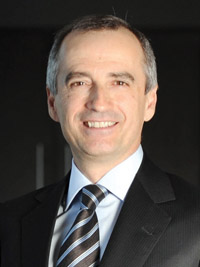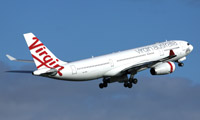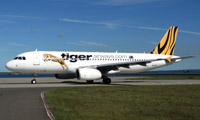ORIENT AVIATION PERSON OF THE YEAR 2012
JOHN BORGHETTI
Chief Executive, Virgin Australia
December 1st 2012
BACK TO HAUNT QANTAS
Virgin Australia chief executive, John Borghetti, has achieved what many people thought impossible. The former Qantas high flyer has turned a no-frills cum hybrid airline, formerly named Virgin Blue, into a high quality, full-service carrier with global reach. In recent weeks, Singapore Airlines has agreed to take a 10% share in Virgin and Virgin is to take a 60% share in Tiger Airways. There is much more to come, says Borghetti.
 |
| ORIENT AVIATION PERSON OF THE YEAR 2012 |
| JOHN BORGHETTI Chief Executive Virgin Australia |
Back in 2008, John Borghetti missed out on Qantas’ Airways top job to his then colleague, Alan Joyce. But in a twist of fate Qantas’ loss has turned out to be Virgin Australia’s gain. The 56-year-old airline operations veteran has become one of the biggest bees in his former employer’s bonnet.
Borghetti spent 36 years in a wide range of senior roles at Qantas before leaving in May 2008. A little over two years later, in March 2010, he was appointed chief executive of Virgin Australia.
“What we have achieved in the past two-and-a-half years will pale into insignificance compared with the next two and a half years,” he said. Fighting words indeed.
Virgin chief Borghetti is a man of surprises and he has a few more up his sleeve. But he isn’t telling just yet. No point in giving his competitors any advance notice, he said.
Those who doubt him need only look at his track record since he took the reins of the carrier. At the time, the former no-frills Virgin Blue had changed its spots. It had become a hybrid “New World” airline. It was struggling.
But in a remarkably short time, Borghetti morphed Virgin Australia into a high quality, full-service airline group that offers its passengers access to destinations around the world.
Urbane and street smart, he changed the brand. For starters he dumped “Blue” from the name. Previously operating offshore under a variety of names because an agreement with Singapore Airlines, 49% owners of Virgin Atlantic Airways, meant the Virgin brand couldn’t be used internationally, he resolved the issue so that the various divisions could be consolidated.
He created his own virtual global alliance through bilateral deals with major offshore partners, Singapore Airlines (SIA), Etihad Airways, Delta Air Lines and Air New Zealand.
He drew up a five-year business plan that persuaded some of the partners to invest in Virgin without a seat on the board. In addition to major shareholder Sir Richard Branson’s Virgin Group’s 26%, Air New Zealand has 20% equity and Etihad 10%.
Last month, Borghetti surprised the industry again with another round of unexpected developments.
 |
| Virgin Australia: one of the youngest fleets in the world |
He announced:
* 10% of Virgin Australia will be sold to SIA for $105 million.
* Virgin will pay $35 million for a 60% share in budget carrier, Tiger Airways Australia, which is part-owned by SIA.
* it planned to spend another $99 million on a 100% takeover of major Australian regional airline, Skywest.
Borghetti announced at last month’s annual general meeting that Virgin made a pre-tax profit of $85.8 million in the latest year ended June 30. A net profit of $22.8 million was a 134% increase over the previous 12 months. He expects an even better result this year once acquisition costs for the stake in Tiger and the take-over of Skywest are excluded.
Virgin also expects to exceed its 20% target of domestic revenue from the corporate and government markets, he said, as well as growing its Velocity frequent flyer scheme from 2.5 million members in 2010-11 to 3.2 million in 2012-13.
The airline is looking for $415 million in efficiencies and productivity gains in the next three years. Meanwhile, Virgin had a goal to boost Velocity membership to five million by the end of 2014-15.
Just how much has changed hit Borghetti on a Virgin Australia flight about six months ago. “I looked around and it occurred to me there was not one thing that was the same as when I joined,” said Borghetti.
“It’s just the beginning, not the end. If you look around the world at the airlines that find themselves in trouble today they are, typically, the airlines that stood still for a while.
“You will never see us standing still. You will always have the next big step coming.”
| 'What we have achieved in the past two-and-a-half years is going to pale into insignificance compared with the next two and a half years' |
| John Borghetti |
The latest transactions are significant. They not only cement investment in its operations by major airlines, but Virgin re-enters the low-cost carrier (LCC) market, abandoned with the transformation of Virgin Blue. And it opens doors into new markets.
The Skywest deal still has to receive regulatory approval, but the regional carrier – it will be rebranded as Virgin Australia – is involved in the lucrative fly-in-fly-out, or FIFO, business, which ferries workers to and from mining operations in remote parts of Australia, mainly Western Australia and Queensland.
The strategy ramps up the pressure on Qantas, which still controls more than 60% of Australia’s domestic market. However, Borghetti is adamant it is not about market share.
“Our position on market share has not changed. We don’t have any market share target. It is about earnings. It is about yield. It is about building a sustainable business that is active in every sector,” said the Virgin boss.
“It’s obvious we are a smaller player in this market than our competitor [Qantas], but we are growing in scale. I believe we are a more formidable group now.”
Borghetti is changing the competitive dynamic. As Virgin Australia abandoned budget flying and focused on capturing more corporate customers, it was competing with Qantas mainline and its budget subsidiary, Jetstar. Now, it can focus on vying with Qantas while Tiger grows and confronts Jetstar. If approved, the acquisition of Skywest will allow it to better compete against Qantas’ domestic regional, Qantas Link.
 |
| Tiger Airways Australia: Virgin has bought a 60% holding in the carrier |
Borghetti said Virgin is delivering on its strategy. “There is no question it is going to enhance competition in this country. It must. We are entering into markets where we are very small or not participating in at all,” he said.
“We have seen the impact on fares when we entered into the corporate business market in the last year or so. We have seen the impact when we entered into some of the regional ports with our turboprop operations.
“In both cases airfares dropped anywhere between 20% and 30%. When we flew to the U.S. fares dropped 25%. It’s good for consumers, but it is also very good for jobs because it stimulates demand and that means growth.”
Borghetti said the arrival of SIA as a shareholder showed the confidence Virgin’s partners have in its business plan and its future.
“It isn’t just a lick of paint on an aircraft, it’s the way we have positioned everything, including the international network. I’m not sure if I know of any other airline that’s got four alliances to different parts of the world that have anti-trust immunity,” he said.
Creating a virtual global alliance through bilaterals had always been the plan. “I knew we couldn’t join one of the existing alliances for the simple reason that, firstly, we couldn’t afford it and, secondly, no matter who we joined we were always going to be the tail on the dog,” said Borghetti.
“Can you imagine joining Star or Skyteam and you sit next to a guy at a meeting who’s got over a thousand aeroplanes and a huge staff and you are just a small carrier. Every time you put your hand up they are going to say: sorry who are you again?
| 'We don’t have any market share target. It is about earnings. It is about yield. It is about building a sustainable business that is active in every sector' |
| John Borghetti |
“The other issue is that you couldn’t possibly get anti-trust immunity with all the carriers that mattered. Bilaterals are certainly the way to go and I question the longevity of some of the global alliances.
“We are tailoring our bilateral alliances to do precisely what is best for us. We are fortunate we have four of the best airlines in the world in their respective regions.”
Some eyebrows were raised at the Tiger deal. The carrier was grounded last year by Australia’s aviation regulator for safety issues, but it was recently cleared to return to full operations.
Borghetti is confident the episode is behind the no-frills operator. It will remain as Tiger Airways and will not be re-branded, operating as a stand-alone business.
“There will be co-ordination, but we have studied very carefully managing a two-brand strategy and one of the things we have learned is what not to do,” he said.
“For example, we won’t code Virgin Australia on Tiger or put the Tiger code on Virgin. We have to make a distinct separation in the marketing, the brand and the consumer expectation of what they are booking.”
Borghetti said Tiger has “run a good business” despite its past issues. “In my view we can deliver many benefits to the joint venture in all aspects. The Tiger brand is very strong. Even in Australia, when you consider some of the issues it has had, the brand has been very resilient.”
Virgin has committed to investing a further $62.5 million in Tiger Australia, increasing its fleet of 11 A320s to 35 aircraft by 2018.
Borghetti said he was trying to make Virgin Australia a stable, value-creating, non-cyclical exposed business. “Right from day one the biggest enemy of this business has been its earnings volatility,” he said.
In the year Borghetti took over, Virgin made money in the first half and lost more than $100 million in the second half. Last year, it made $90 million in the first half and lost $15 million in the second half of the year.
While still a loss, it was a huge difference and clearly showed “the trajectory is heading in right way. Judge me in three years time, I know we can do it by the end of the fifth year”, he said.
“Everything we do is aimed at avoiding volatility, to smooth it out and grow.”
When Borghetti arrived at the airline, Virgin had 79 aircraft. It now has 106. With the new interest in Tiger and the proposed acquisition of Skywest its combined fleet will be 140 planes.
“If you look at deliveries, in two-and-a-half years our fleet will be close to 180 or 200 aircraft,” he said. The carrier will grow incrementally, but cautiously, with most international network expansion taking place through its partners, he added.
“We don’t need any more long-haul aircraft. Flying to Europe is not on the radar. We know our limitations and it’s Australia, regional, the Asia-Pacific and the U.S. for us. You’ll see us growing in medium-haul rather than long-haul.”
The carrier has ordered 23 B737 MAX for single-aisle expansion. It will be undertaking evaluation of its twin-aisle requirements next year.
From 2017, Virgin will be looking at the B787 Dreamliner and the A350. It currently operates B777s and A330s. “We’ll make a call by the end of the year,” said Borghetti.
Virgin has one of the youngest fleets in the world, with an average age of 4.2 years.
Borghetti is reticent to engage in any verbal duels with Qantas, his former employer. He said of the recent alliance deal between Qantas and Emirates Airline: “We’ve analysed what this would mean for us if it gets approved [from the competition regulators] and we fail to see any negatives.
“There is an argument that we could see it as a small advantage. Obviously, I am not going to articulate that to everybody because it would elaborate on our strategy, but we certainly don’t see it as a disadvantage.”
Virgin is already competing with Emirates, which has more than 90 weekly flights into Australia. “Whether Qantas is attached to them or not, these flights are still there. Would an extra few flights by Qantas add much of an impact? No, not really. I’m not shaking in my boots,” said Borghetti.
Just after starting at Virgin, Borghetti issued a profit downgrade. At an analysts briefing on strategy, he recalled, most of the analysts were rolling their eyes in disbelief.
“They were thinking what planet is this guy on. What? He’s going to consolidate the airlines to one name. Doesn’t he know you can’t get the licence deal from SIA? He’s going to have an international network without buying an aeroplane? What is he smoking?” said Borghetti.
“You could see it almost without exception. Everybody thought we were mad. Not only did we do what we said we were going to do, but we did it a year earlier than planned.”
There are still a few analysts who doubt what Virgin Australia has set out to achieve in the next few years, said Borghetti. “One thing is sure. We are determined to prove them wrong,” he added.
It is difficult to believe he won’t succeed.
| CITATION: John Borghetti has relentlessly driven Virgin Australia forward, constantly upgrading its services and network. And while the operating climate remains volatile, with immense cost pressures and fierce competition, Borghetti guided the airline to a net profit of $22.8 million in its financial year ended June 30, a 134% increase over the previous 12 months. Strong new shareholders, Singapore Airlines, Etihad Airways and Air New Zealand have arrived to give the carrier a firmer financial base of airline partners. Borghetti has successfully introduced a new livery and morphed a multi-branded operation into what is now essentially a single, recognized full-service airline brand at home and abroad. He has turned a medium-sized regional operator into an airline with global reach. This has been achieved through Virgin’s own network expansion and, more importantly, through significant co-operative agreements with major international partners, Singapore Airlines, Delta Air Lines, Etihad Airways and Air New Zealand. In effect, he has forged his own personal global airline alliance. And while rival Qantas still dominates Australia’s skies, Borghetti has made serious inroads into his competitor’s market, particularly in the corporate travel segment. |
Life in the fast lane
Like his love for motor sports and classic cars, Porsche driving John Borghetti has thrived on adrenalin. For his last six years at Qantas he was the carrier’s executive general manager, responsible for more than $10 billion in annual revenue, up to 16,000 staff and assets including some 200 aircraft.
He headed domestic and international operations, including network operations, scheduling and pricing, sales and marketing, crew, customer service, product and brand. These responsibilities covered all full-service airlines in the Qantas Group, which in addition to Qantas mainline, also included Australia’s regional carrier, QantasLink, and Qantas’ New Zealand operation, Jetconnect. During his tenure as executive general manager, the company achieved its highest reported profit of more than $1.4 billion.
His other achievements at Qantas included the development of a number of subsidiary businesses such as the company’s Holiday Travel operations in Australia and Asia, building its frequent flyer membership to more than five million and increasing Qantas’ Australian corporate travel business.
He played a key role in formulating the company’s two-brand strategy and the introduction of low-cost operator, Jetstar.
Married with two adult children, Borghetti is fluent in Italian. In addition to his interests in cars, he is passionate about Australian Rules football.